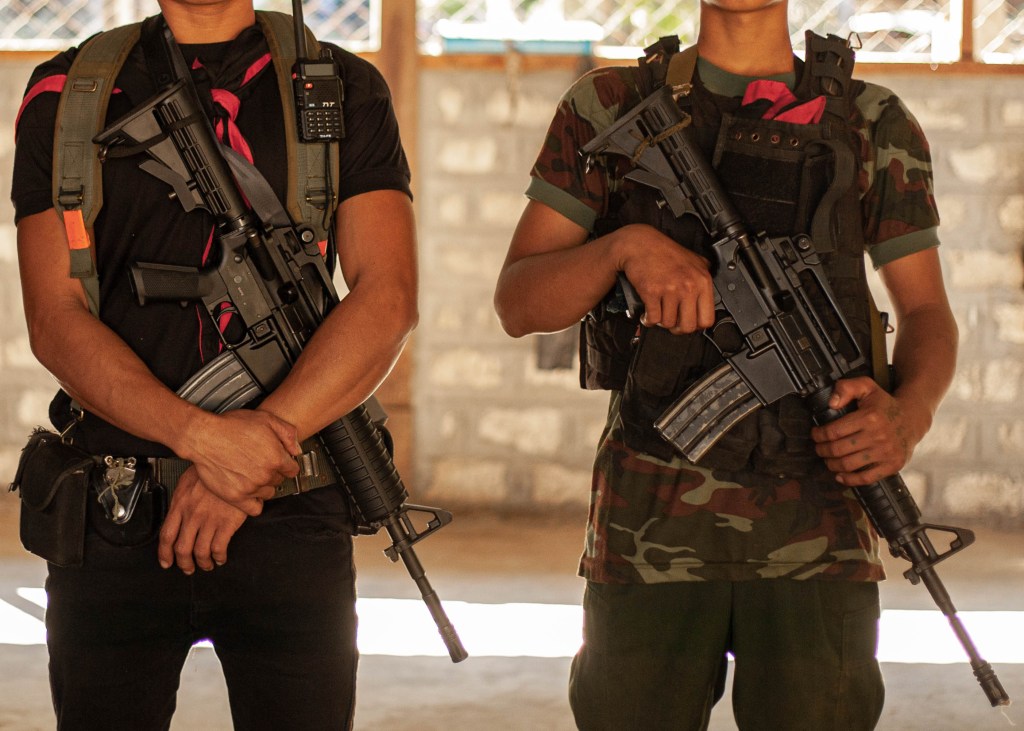CALI, Colombia – For days, residents of the city of Cali in Colombia begged protesters to lift road blockades that had cut them off from receiving food and fuel supplies.
Finally, some civilians decided to take the law into their own hands. Armed men dressed in shorts and white shirts jumped into giant SUVs and drove to one of the blockades where members of an Indigenous group were stationed blocking an intersection. Then, they drew their weapons and fired.
Videos by VICE
Members of an Indigenous group known as the Regional Indigenous Council of Cauca (and its Spanish-language acronym, CRIC) behind the blockades reported 10 of their members wounded from the attack on Sunday night.

The incident took place in the city that has become the epicenter of a national wave of protests against the government of President Iván Duque that have left more than 46 dead. Now, there are fears that parts of the country could once again descend into civil conflict.
In 2016, Colombia forged a peace accord with its largest rebel group Revolutionary Armed Forces of Colombia (FARC). Many Colombians hoped to move on from a long and violent chapter, in which rebels in rural parts of the country kidnapped ranchers and ran drugs, paramilitaries massacred villages and crime bosses paid people to assassinate police.
Duque has responded to the unrest by sending in anti-riot police and the military to affected cities where unrest has turned violent. There have been widespread reports and video footage of the excessive use of force by the security forces to suppress the unrest.
The pop of gunfire could be heard through Cali’s suburban streets during the attack on the blockade, as civilian shooters crouched behind trees and hiding in their cars fired their guns down the road.
“During a heated exchange between Indigenous protesters and counter-protesters, heavily armed civilians arrived at the scene. And as the argument escalated, they began shooting,” said Indigenous activist Fabio Alonso Guacheta Giron to VICE World News.
As gunfire erupted, protesters scrambled and screamed, ducking for cover behind trees and vehicles on the crowded intersection, video footage of the incident showed.
“We urge (authorities) to investigate and sanction the attack that left at least eight Indigenous injured, among them various female leaders and defenders,” said Juliette de Rivero, the United Nations High Representative for Colombia on Twitter.
Months of pandemic lockdowns and subsequent joblessness have fueled the ire behind the current wave of protests in Colombia, which began on April 28. The list of victims includes students, activists and police officers, reported Human Rights Watch.
Demonstrations in the days following quickly escalated when protesters stacked their anti-tax anger onto long-standing grievances tied to yawning inequality and a lack of basic protections for human rights. The demands grew especially loud from local activists and minority groups in rural areas where Colombia’s 50-year armed conflict once raged and left hundreds of thousands dead and millions displaced.
Those grievances appear to have gone unresolved in spite of the peace process that was supposed to stitch the country back together.
After what seems like several minutes of armed confrontation in Cali, the men in the trucks circled back and sped away. People near the blockade that had come under fire can be seen scattering in a frenzy of confusion.
But it is unclear who the armed men in white SUVs were and whether they acted on behalf of authorities or alone. It is also unclear who fired the first shots in the skirmish.
“I am enormously worried about the attacks against protesters in Colombia by armed people dressed as civilians,” said José Miguel Vivanco, the Americas director for Human Rights Watch, in response to the attack.
“The government has the obligation to protect peaceful protest. Those responsible for these terrible acts must be brought to justice.”
Sympathizers with Duque’s government have suggested that civilians could have armed themselves and attacked the protesters in response to an alleged incident where cars rammed into a gated community and began looting.
“These aren’t protesters,” tweeted Rafael Guarin, Duque’s national security advisor. “These are criminals.”
But the residents of Cali are growing frustrated with what they perceive to be a limp security response to protesters. One man’s voice grew shaky as he promised consequences for the blockades.
“People with human rights groups are saying [the police] aren’t allowed to do anything. I’m 80 years old and I want to take on these miserable wretches,” said Máximo Tedesco, an engineer, in reference to the protesters blocking roads.
“I’m not afraid of them at all.”
Duque’s government has insisted that the National Liberation Army (ELN) and other organized crime groups are behind the protests and blockades in Cali, effectively framing the demonstrations as backed by crime bosses with an interest in stoking social unrest.
From Bogota, President Duque said: “We repeat our request for the members of the Indigenous guard of Cauca to return to their reserves.”
By Monday evening, the city was deserted with the military patrolling the streets. Local officials imposed a strict curfew and trucked in food and supplies with military caravans.
Duque has pledged to bring calm back to the city of Cali. There are peaceful marches planned for today around the country and so far, there are no further incidents of armed civilians taking up weapons. But Colombia’s wider bout of civil unrest does not look like it will dissolve any time soon.
“What people have to understand is that these attacks are nothing new,” Edgar Valesco, an Indigenous leader, told VICE World News.
“They’ve happened for decades. Usually they happen in the countryside, far away from cameras and journalists. This one just happened to be caught on film, so suddenly it’s news.”





